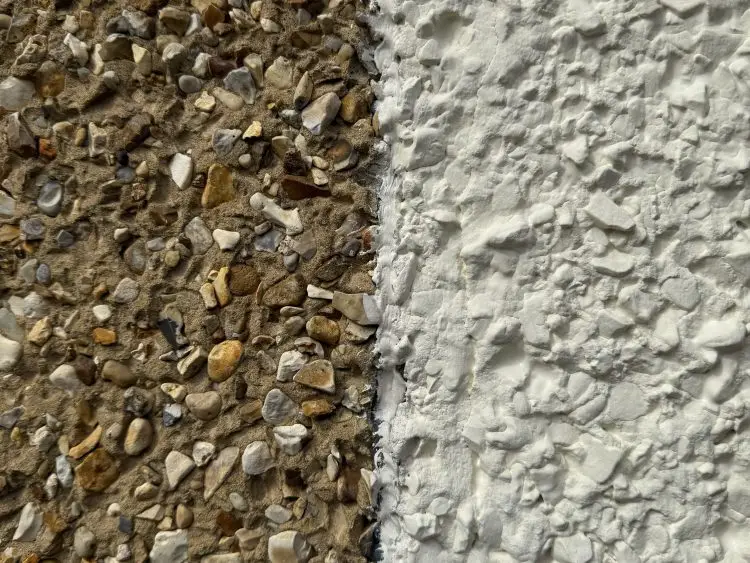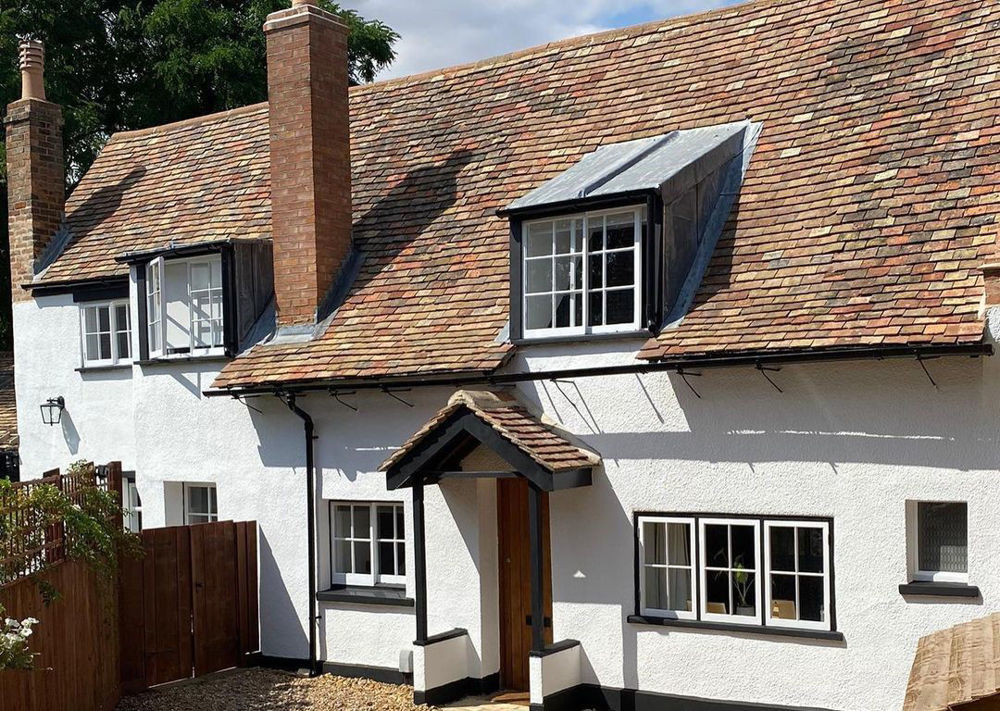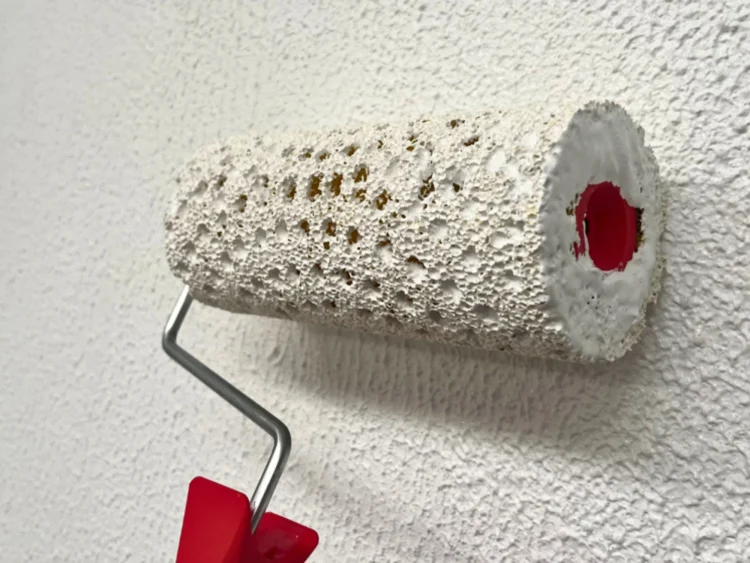The Ultimate Guide To Painting Pebbledash
Pebbledash has protected British homes for decades, but it’s not always the look homeowners want today. Should you paint it, remove it or leave it as it is?
In this guide we’ll explain:
- What pebbledash is
- What to consider before painting or removing it
- How to paint pebbledash
What Is Pebbledash?
Pebbledash is a very rough form of render used on exterior walls, made up of cement and lots of small stones and rocks that are thrown on to the wet surface to create an even coating across the wall.
While pebbledash involves putting the stones on the top of cement, a similar form of textured render is roughcast, which involves mixing the cement and the stones together and then applying.
Pebbledash has fallen out of favour in recent years, particularly if left bare and unpainted. Some property experts even suggest it could devalue your home, with one survey finding one in four buyers would look elsewhere, if they saw pebbledash when viewing a property.
As a result, more and more homeowners are choosing to modernise their exteriors by painting or removing pebbledash to achieve a cleaner, more contemporary look.

Can You Remove Pebbledash?
If you are looking to get rid of pebbledash completely from your property, then it can be removed, but there are a few things to consider.
Underneath the render, there is little way to determine the condition of the property. The structure may be perfectly healthy underneath, however removing the render in some cases could reveal a whole host of issues. It may reveal poor brickwork and crumbling pointing that have been hidden for some time. The process of removing the render can also create further damage. Because of this, it’s always best to go into the process prepared for further work.
It’s possible to remove pebbledash yourself but it is a difficult task. This means that it is your best option to get a professional to remove this, plus they will be most likely required to undertake any remedial work even if you managed to strip the pebbledash yourself.
The cost of removing pebbledash can vary. Checkatrade estimate that having pebbledash removed is likely to cost £2,100 to £7,800 depending on the size of the property. This does not include the remedial work or any painting of the property.
Is Painting Pebbledash a Good Idea?
Yes, painting pebbledash is a great way to modernise your home without the high cost of removing it and re-rendering it.
It’s true that pebbledash is harder to paint than smooth render, but with the right preparation and a high-quality paint, it’s something most homeowners can do themselves.
Pebbledash is tough but porous, meaning it naturally absorbs water from rainfall over time like most exterior walls. A fresh coat of doesn’t just improve appearance, it helps keep your home dry and reduce the risk of damage.
The key is to use a paint that not only protects pebbledash but also allows it to naturally breathe.
This is why we developed Emperor Masonry Paint, which creates a super hydrophobic (ultra water-repellent) surface on exterior walls without affecting the breathability. By keeping walls dry, it has been proven to perform for over 25 years without peeling and is backed by a lifetime guarantee.
Learn more: How Emperor Masonry Paint offers the best of both worlds
How To Paint Pebbledash
Painting pebbledash can require more time and care than painting smooth render, but with the right tools, paint and approach, you can achieve a lasting, professional finish.
YOU WILL NEED:
- Long-pile roller
- Paint scuttle
- Masonry brush
- Dust brush
- Sandpaper
- Dust sheets
- Masking tape
The equipment needed to paint pebbledash is similar to any other painting project with the difference of the roller and brush. Ensure you get an extra long-pile roller, which is perfect for painting heavily textured surfaces as it can reach the gaps between the pebbles much more effectively than a standard roller. A 4″ masonry brush with longer bristles will also help you reach those tricky nooks and crannies.
When finding the right equipment, we recommend you buy the most expensive you can afford. The better the quality, the better the finish you will achieve and the easier you will find the process. While it is tempting to save money on tools, especially if you do not paint very often, they will save your time in the long run.
1. PREPARE THE SURFACE
Preparation is one of the most important aspects of any decorating project.
Removing any dirt and decontaminating the surface is the first step. Use a dust brush to remove any visible dirt and dust from the surface. Once this is done, assess walls for any signs of cracks or damage and if required use exterior filler to make any repairs.
Due to the texture of pebbledash, it often gathers dirt across the surface. That’s why before painting pebbledash it’s important to clean it using a hosepipe to remove as much dirt as possible.
Once dry, protect any surfaces such as windows, sills and trim with masking tape and dust sheets.
If the pebbledash hasn’t been painted before, apply a primer next. This helps the paint stick to the wall and ensures even coverage. This can be applied with a roller, brush or pump sprayer and only needs one coat.
2. PAINTING THE PEBBLEDASH
Once your walls are clean dry and primed (if needed), it’s time to paint.
Pebbledash is more challenging to paint than smooth surfaces, but a high-quality paint and the right tools makes the job much easier.
Start at the top and work down. Use a masonry brush to paint around the edges of the wall before coating the rest of the wall. A masonry brush is ideal for the first coat because it helps you reach into all of the small gaps between the stones. Take your time to work the paint into the surface rather than brushing over it lightly.
For the second coat, switch to an extra long-pile roller. This ensures full coverage across the textured surface and creates an even, consistent finish.
Frequently Asked Questions
Does Pebbledash Cause Damp?
It’s common to see signs of damp on pebbledash, but pebbledash doesn’t cause damp, although it can be part of the problem.
Like any render, the pebbledash can break down, leaving gaps in the protective barrier. Once even the smallest gap opens up, moisture can get underneath the render and soak into the exterior wall. As more water enters the wall, it only worsens over time.
Bare pebbledash is also porous, meaning it naturally absorbs water. Over time, this moisture can become trapped and seep into the interior wall, leading to penetrating damp.
Painting pebbledash helps protect it, but also if the paint is highly breathable. Not all paints work in the same way – standard masonry paints aren’t highly breathable so in fact can make damp problems worse.
Emperor Masonry Paint is able to reduce water absorption by up to 96% while remaining highly breathable, thanks to cutting-edge nano-technology. This means it can help reduce the impact of damp, instead of contributing to it like many modern masonry paints.
Should I use smooth or textured masonry paint on pebbledash?
It’s a common misconception that you should use a textured masonry paint when painting a textured render.
Smooth masonry paint in most cases is the best option as it will simply coat over the existing texture of the pebbledash without the complication of impacting the texture.
You can use a textured masonry paint, but this won’t change the underlying textured of the pebbledash and can be more difficult to apply.
How Do I Repair Pebbledash?
A common problem with all rendered surfaces is uneven finishes as a result of repairs made to cracks and holes.
These surfaces once repaired can stick out and draw attention, which is the last thing you want when giving your home a new look.
In order to help with covering these problems, we developed Emperor Textured Basecoat, which can be applied to exterior masonry surfaces in order to create a wide range of finishes. It’s applied with a brush or textured roller to cover surfaces and create a seamless textured finish.
Crucially, it contains the same highly breathable nano-technology as our Emperor Masonry Paint, meaning the performance of your walls is not compromised.
Ready to start your project? Order a sample of Emperor Masonry Paint and start your transformation of your pebbledash render.
Not sure which products you need? Take our handy quiz to get personalised recommendations and find the right products for your project in a few clicks.
This article was written by the Emperor Technical Team, a group of experts with an average of over 25 years experience in the building industry. They work daily with homeowners, tradespeople and specification professionals to deliver practical, expert guidance that promotes long-term results, supports wall health and helps create homes that are prepared for the future.











